Reviews
Philip Guston Holds His Own Next to the Venetian Masters at the Gallerie dell’Accademia
If you only see one Venice Biennale collateral show, let it be this one.
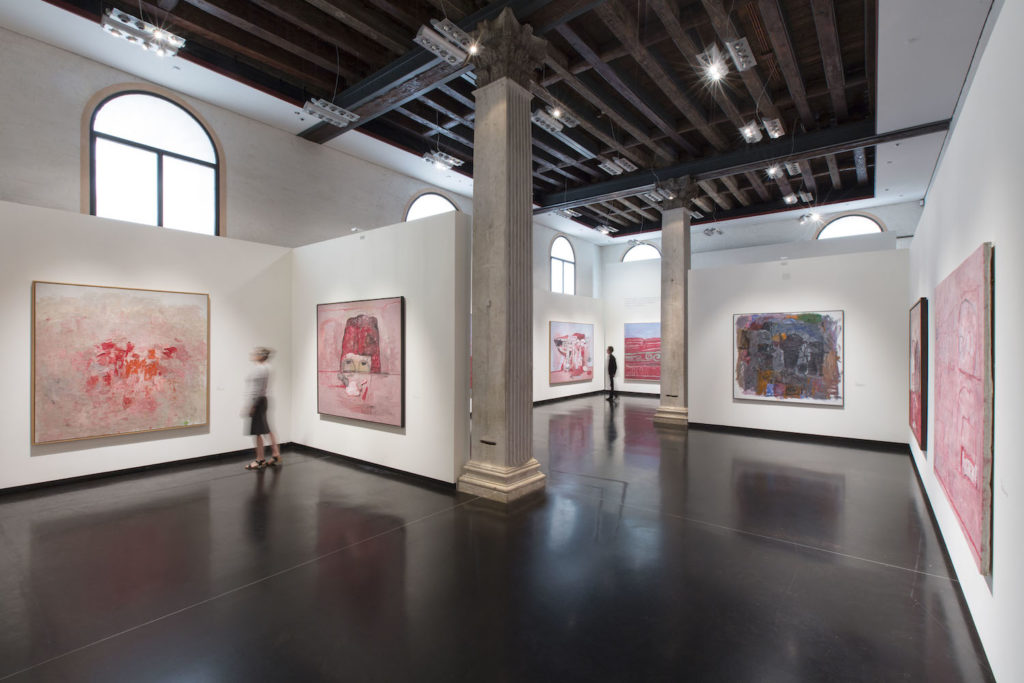
If you only see one Venice Biennale collateral show, let it be this one.

Lorena Muñoz-Alonso

If you’re in Venice and experiencing Biennale fatigue (endless queues everywhere, and so much Instagramming going on) there’s a miraculous antidote to all that. At the Gallerie Dell’Accademia—home to a trove of masterpieces by Bellini, Veronese, Tintoretto, Titian, and Tiepolo among many others—the curator Kosme de Baraño has organized the first museum exhibition of the late American painter Philip Guston in Venice. And it’s an epic affair.
Gathering over 50 paintings and 25 drawings dating from 1930 to 1980 (the year he died), “Philip Guston and the Poets” explores the oeuvre of the artist through the lens of five writers who were major influences on his artistic work: D.H Lawrence, W.B. Yeats, Wallace Stevens, Eugenio Montale, and T.S. Eliot.

Philip Guston, The Studio (1969), ©The Estate of Philip Guston.Private Collection. Photo Genevieve Hanson.
Works from his late period, those featuring his signature cartoonish, bulbous figures are well known and loved by many. Even so, nothing can prepare viewers for the exhilarating spectacle of a massive room full of Guston canvases, one after the other.
Here we find The Studio (1969), Signals (1975), Wave (1979), and The Line (1978), featuring that ominous veiny hand descending from a cloud to paint a line on the earth, open to so many interpretations. Or the poignant East Coker, T.S.E (1979), after Eliot’s epic poem of the same name and depicting an old man laying on his deathbed, which Guston painted a year before his own passing.
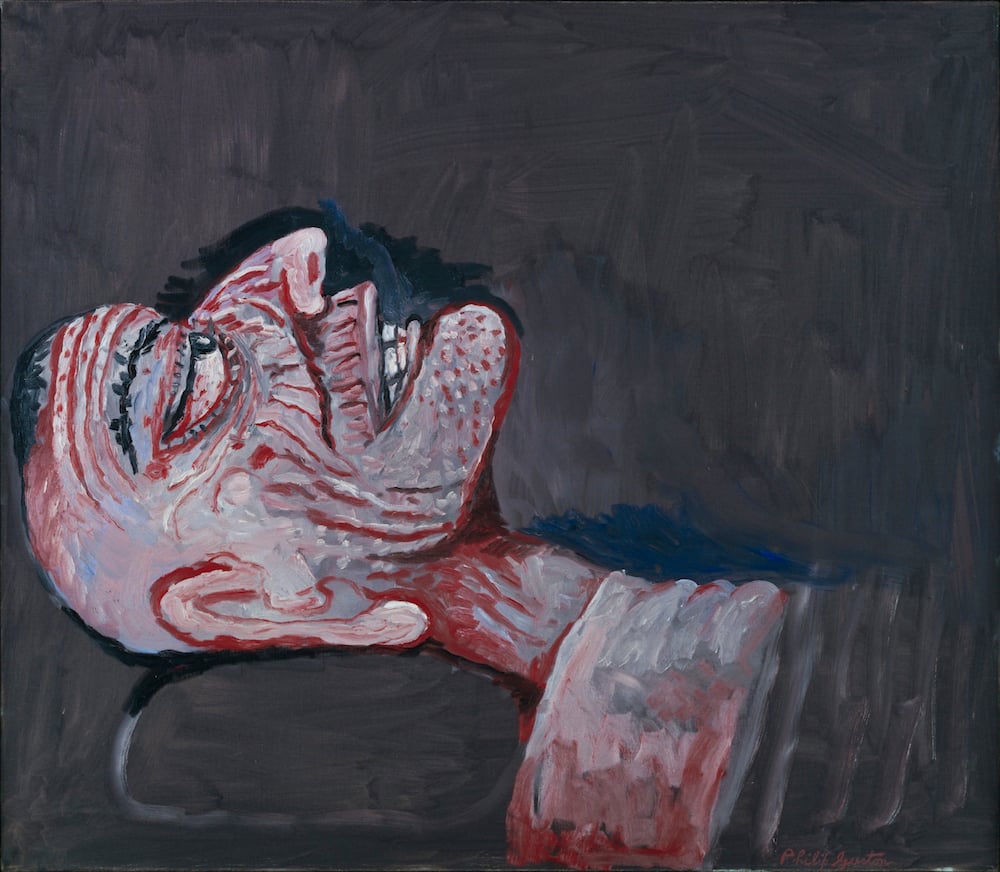
Philip Guston, East Coker – T.S.E. (1979), ©The Estate of Philip Guston
The Museum of Modern Art, New York. Gift of Musa Guston, 1991. Digital Image ©MoMA, NY.
Guston’s relationship with poetry was intense, nourishing, very personal, and not limited to just being a reader of the greats. In the show, there’s a beautiful section devoted to the works he created to illustrate the poems of his wife, the poet Musa McKim, in the mid-1960s. By the 1970s, he had established a series of artistic collaborations with a number of young poets and friends, including Bill Berkson, Clark Coolidge, and Alice Notley.
The “poem-pictures” he created for them have not been shown often and are definitely some of the gems in this show. Small and humble, just black ink on paper, they are mostly haikus on daily life, like the one made for McKim’s observations on a trip to Italy, or existential riddles, like the one for Coolidge’s “Next to the painting a painting of a hand painting.”
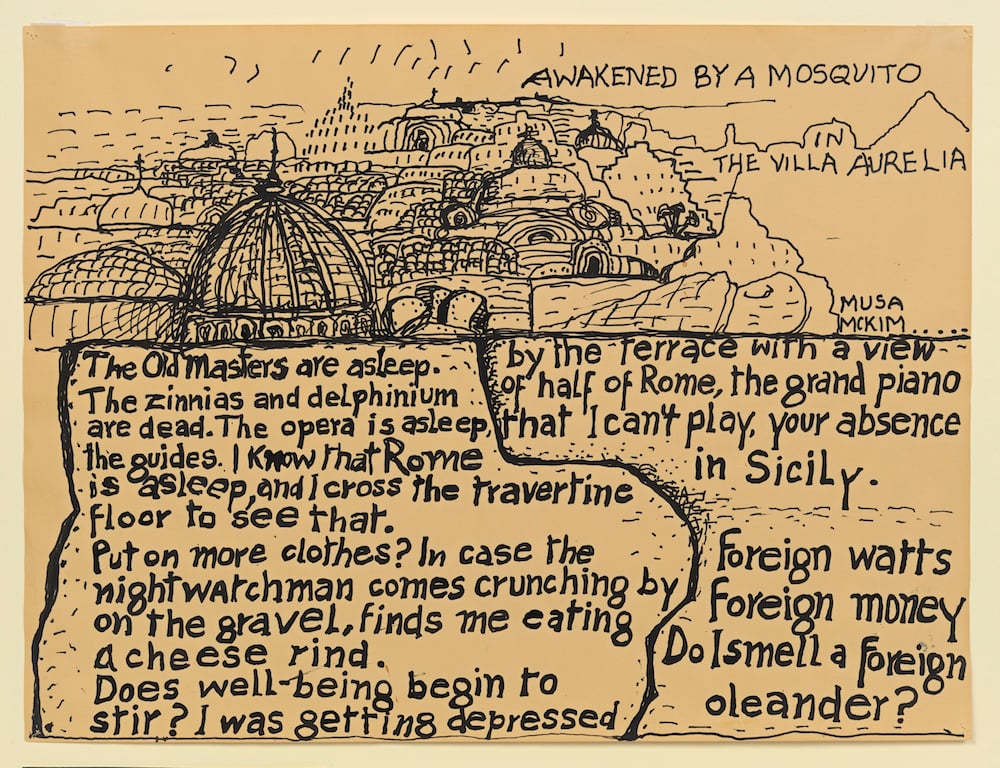
Philip Guston, Awakened By A Mosquito (c. 1972 – 1975). Photo Genevieve Hanson.
But perhaps the most surprising part of the exhibition is the one dedicated to his early production. It’s in the early works of Guston that we see his love for Italian classical art shine in full splendor. Moreover, the scholarly dialogue staged between Guston’s works and the Italian masters he learned from opens exciting lines of art historical inquiry.
For example, Guston drew the figures in Masaccio’s Saint Peter Healing the Sick with Shadow and The Tribute Money over and over again throughout his life, first as a student (these exquisite studies are included in the show), and then with cartoonish flare in his adult life.
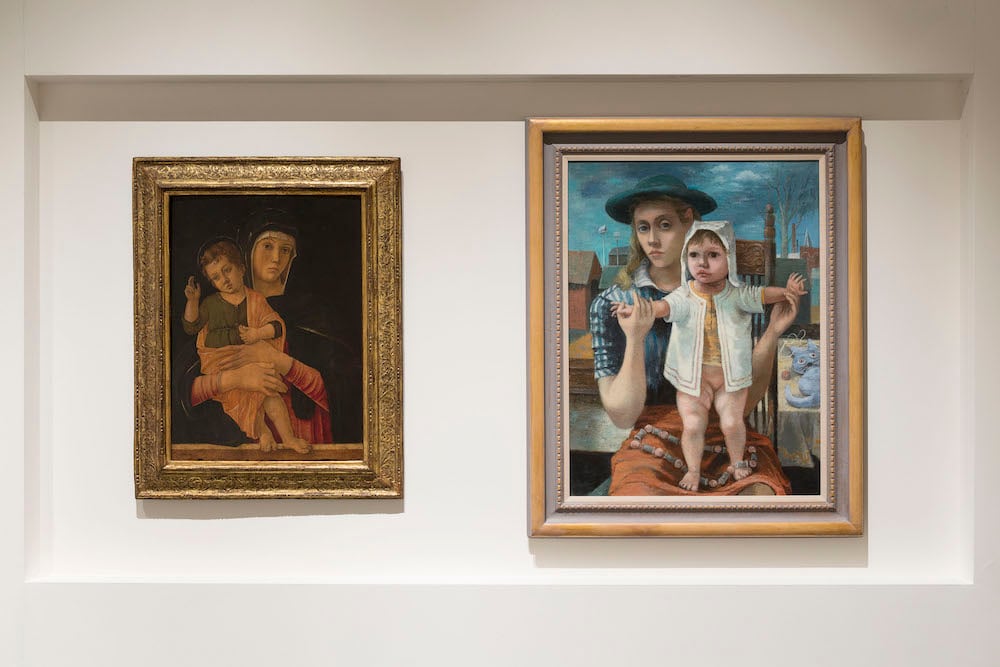
Giovanni Bellini’s Madonna and Child (c.1470) and Philip Guston’s Young Mother (1944) at Gallerie dell’Accademia, Venice. Photo Lorenzo Palmieri, ©The Estate of Philip Guston, courtesy of the Estate, Gallerie dell’Accademia, and Hauser & Wirth.
Here, we also see Cosimo Tura’s Madonna Dello Zodiaco (1459 – 1463) next to Guston’s Mother and Child (1930), and Bellini’s Madonna and Child (c. 1470) next to Guston’s Young Mother (1944); two beautiful pairings that reveal a lesser-known side to Guston’s work and how formative the Italian masters were in his development.
In fact, never afraid of revealing his hand, at the very start of the exhibition viewers encounter Guston’s Pantheon (1973), in which he painted the names de Chirico, Masaccio, Piero, Giotto, and Tiepolo, and which reads like a statement of his influences.
From those formative years based in classic and modernist figuration, the exhibition’s journey takes us to Guston’s Abstract Expressionist years. Although Guston was very successful as part of the New York School, his output during that time seems inconsistent (even if the works exhibited at the Accademia are all prime examples of Guston at his best as AbEx painter).
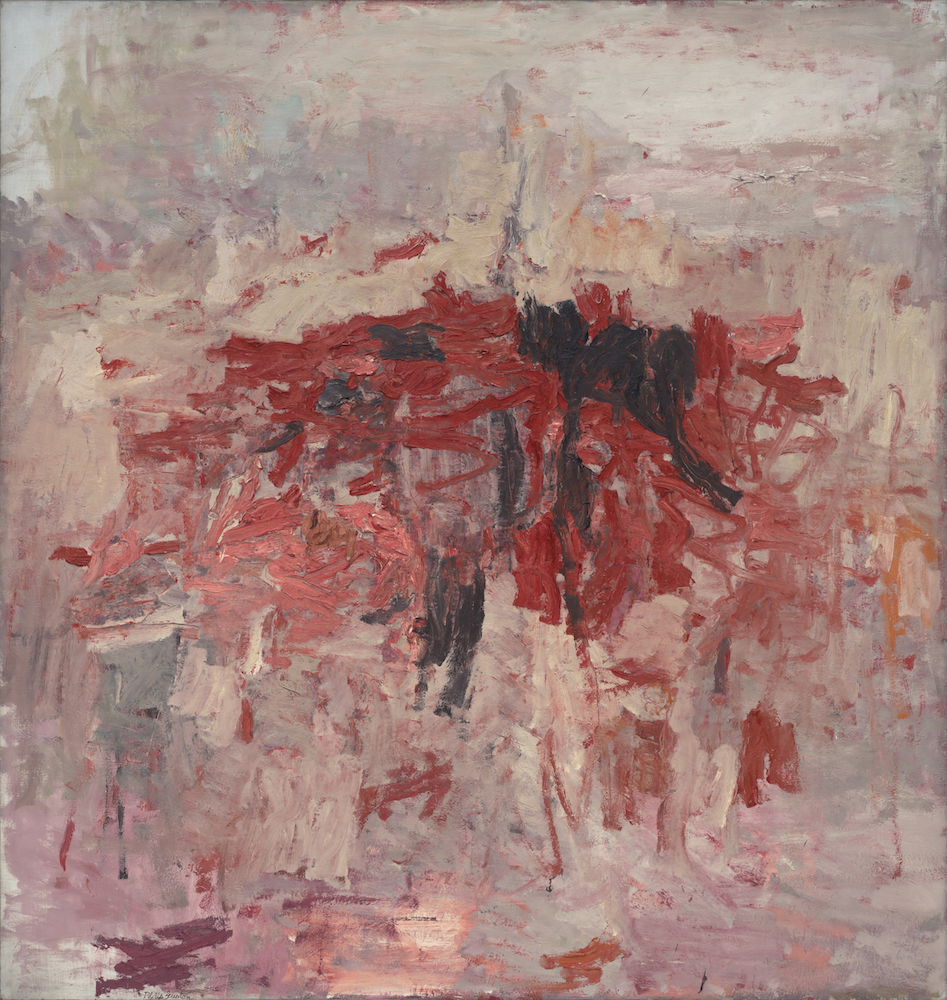
Philip Guston, For M. (1955), ©The Estate of Philip Guston, San Francisco Museum of Modern Art. Anonymous gift. Photo Ben Blackwell.
It’s almost as if Guston felt some kind of “peer pressure” to join the ranks of abstraction when he moved to New York in the 1950s. Eventually, towards the end of the 1960s, his pull toward figuration was too strong and he returned to it, honing the cartoonish compositions that would become his signature style (however, a documentary shown in the exhibition tells us that, despite how important the distinction between figuration and abstraction may be for those discussing his work, for Guston himself nomenclature wasn’t a key consideration.)
Crucially, even in his late work, a myriad of Italian symbols appear, from the monumental feet that reference the country’s Greek and Roman heritage to the modern cityscapes in his Roma series.
It comes as no surprise that Guston visited Italy extensively. First, when he was awarded the Prix de Rome in 1948, then in 1960, when he represented the US at the Venice Biennale, and then again as an artist in residence in Rome, in 1970.
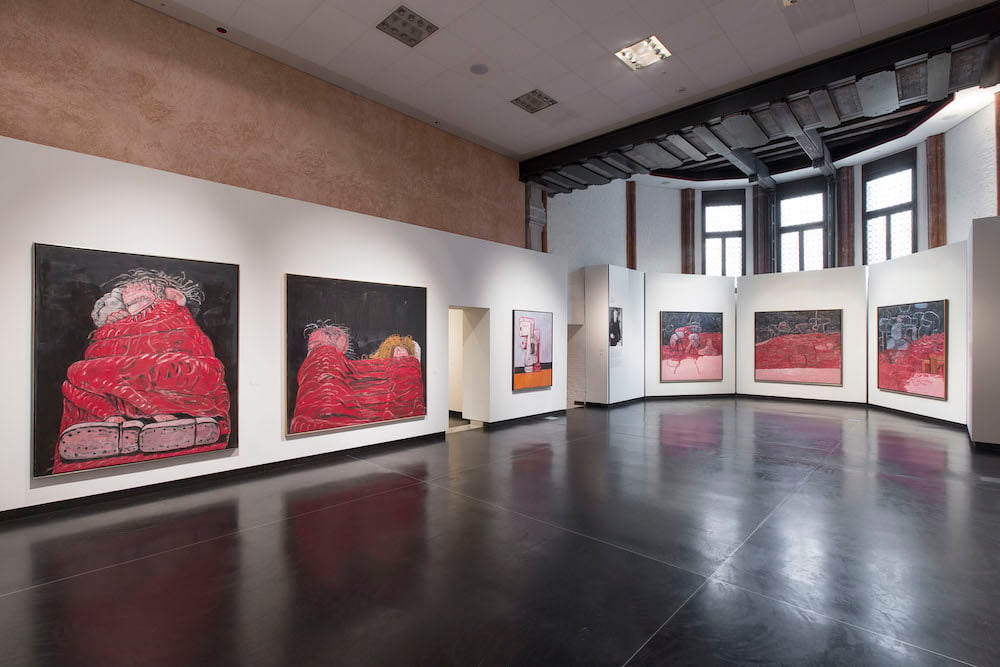
Installation view, “Philip Guston and The Poets” at Gallerie dell’Accademia, Venice. Photo Lorenzo Palmieri, ©The Estate of Philip Guston, courtesy of the Estate, Gallerie dell’Accademia, and Hauser & Wirth.
But it does seem odd that, despite his love for and knowledge of Italian culture, Guston never showed in a major Venice museum during his lifetime. Which is why there’s a certain sense of poetic justice about this exhibition, staged in the illustrious venue that houses some of his favorite artists.
Yet, although the curatorial conceit of pairing his work with the poets who were important for him and even directly referenced by him is sophisticated and well carried out, it sometimes seems to burden the show with too much narrative.
Guston’s work, at the end of the day, needs very little trimmings and not very much to lean on: just a room full of his paintings and time and space to enjoy his metaphysical, humorous, and unique pictorial world. Do not miss this show.